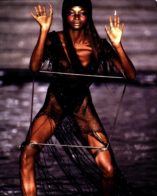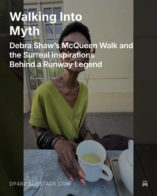https://www.youtube.com/watch?v=oHuaZfEg0JY
Dear Shaded Viewers,
Please enjoy a chat with Debra Shaw. The Legacy: Beauty With Attitude Debra Shaw smashed through rigid beauty standards—her refusal to “just fit in” inspired designers to create theatrical, mood-driven experiences around her, most famously with Galliano and McQueen. Commemorated on a Gibraltar stamp, immortalized by a Barbie doll, and a mainstay of every true aficionado’s mood-board—Debra’s influence isn’t just surface, it’s structural.
Her Instagram (@madamedebrashaw) is a sultry gallery of Parisian tailoring and poetic mystery, highlighting not just clothes but attitude—a mix of couture poise and savvy wit that is undeniably sexy. “I see my body as an art object.” – Debra Shaw Debra Shaw is the pulse and poetry of the runway. Every look, every pose, is an invitation to fall under her spell—if you’re lucky enough to catch her next Paris show, let her angular beauty and audacious charm remind you: true fashion is about feeling deeply sexy and utterly unforgettable.
Debra Shaw’s historic walk for Alexander McQueen remains an electrifying example of fashion’s power to rewrite myth as reality. Cast for McQueen’s “La Poupée”-inspired show, Shaw arrived at the venue just five minutes before curtain, with no hint of the daunting journey ahead. The runway demanded much more than elegance: she had to navigate perilous stairs, wade through water, and finally step through a glittering frame—a feat conceived by celebrated set designer Simon Costin to capture McQueen’s surreal vision.
The inspiration for this spectacle ran deep. McQueen’s show drew on Hans Bellmer’s “La Poupée” series—an avant-garde body of work from the 1930s that transformed dolls into surreal, fragmented sculptures. Bellmer’s experiments with identity, transformation, and vulnerability spoke to McQueen, shaping not only the mood of the collection but the physical staging itself. Shaw’s walk became an almost ritual sequence: she braved the stairs, unsure if she would make it down; crossed a watery expanse while wearing precarious shoes; and entered the audience’s memory with each step through the gilded frame. The crowd, sensing her tenacity, greeted her arrival with a roar of applause—a communal celebration of creative risk and triumph.
The frame itself became an icon, its sculptural lines a blend of Simon Costin’s theatrical set design and the metallic fluency brought by McQueen’s long-time jewelry collaborator, Shaun Leane. While Costin’s vision anchored the show’s immersive scenery, Leane’s metalwork—from wearable corsets to dramatic adornments—added a sharp, sensual intensity to the catwalk experience.
Behind the scenes, Shaw’s performance was marked by collaboration and improvisation. She remembers telling McQueen before the finale that the frame, having become so iconic, ought to be removed for her exit. Her walk would go on to inspire countless young designers—many of whom grew up watching her navigate not just the dramatic set, but the emotional landscape between muse and movement. Shaw’s intuitive skill made her an early movement director before the role was formalized in fashion, guiding other models and serving as a reference for agencies and creators notablly for John Galliano.
Today, Shaw celebrates the evolving partnership with movement coaches, designers, and artists, recognizing how every show is a tapestry woven of challenge, collective vision, and surreal inspiration. Her McQueen entrance stands as a masterclass in runway resilience—a testimony to Bellmer’s art, Costin’s audacious set, Leane’s sculptural metalwork, and the vibrant, improvisational force of Shaw herself.



